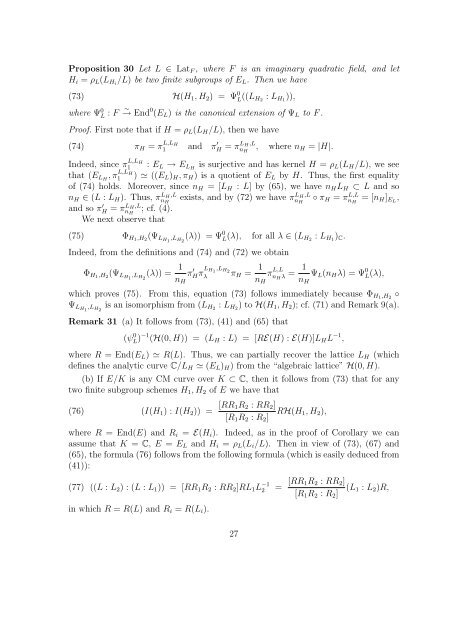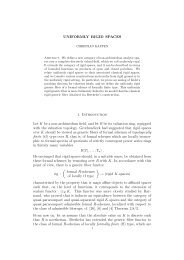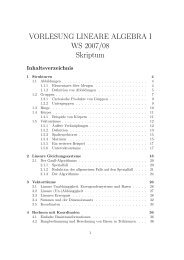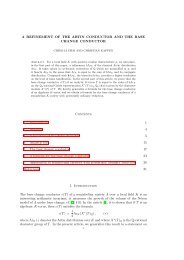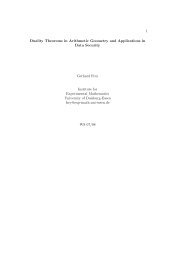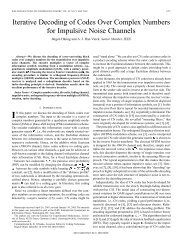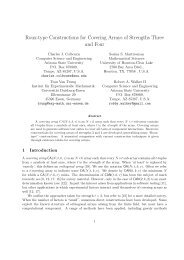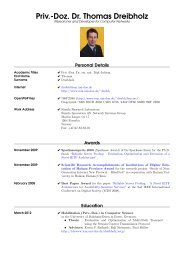Pro<strong>of</strong>. First note that for any two finite subgroups H 1 , H 2 <strong>of</strong> E we have(70)I(H 1 )I(H 2 ) ⊂ I(H 1 + H 2 ) ⊂ I(H 1 ) ∩ I(H 2 ).Indeed, since H i ≤ H 1 + H 2 , we have I(H 1 + H 2 ) ⊂ I(H i ) by (6) and so the secondinclusion <strong>of</strong> (70) follows. To prove the first inclusion, let f i ∈ I(H i ), so H i ≤ Ker(f i ).Since f 1 f 2 = f 2 f 1 , we have H i ≤ Ker(f i ) ≤ Ker(f 1 f 2 ) and so H 1 + H 2 ≤ Ker(f 1 f 2 ).Thus f 1 f 2 ∈ I(H 1 + H 2 ), and so the first inclusion <strong>of</strong> (70) holds.Put n i = |H i |, e i = [R : E(H i )] and N i = [R : I(H i )], so N i = e i n i by (69) (togetherwith the hypothesis that E(H i ) ⊂ R). Since H i ≤ Ker([n i ]), we have n i ∈ I(H i ), andso Rn i ⊂ I(H i ), which implies that N i = [R : I(H i )]|[R : Rn i ] = n 2 i . Thus, since(n 1 , n 2 ) = 1, we see that also (N 1 , N 2 ) = 1 and hence that (e 1 , e 2 ) = 1.In addition we have that I(H 1 ) + I(H 2 ) = R because n i ∈ I(H i ) and (n 1 , n 2 ) = 1.Thus, by elementary ideal theory we have that I(H 1 )I(H 2 ) = I(H 1 ) ∩ I(H 2 ), and soequality holds throughout in (70). Using (68) and (39), we obtain for H = H 1 + H 2thatE(H)R = R(I(H)) = R(I(H 1 )I(H 2 )) = R(I(H 1 ))R(I(H 2 )) = R · R = R,because R(I(H i )) = RE(H i ) = R by (68) and the hypothesis. Thus E(H 1 + H 2 ) ⊂ R.Next we note that H 1 ∩H 2 = 0 (because |H 1 ∩H 2 | | (n 1 , n 2 ) = 1), and so |H 1 +H 2 | =n 1 n 2 . Moreover, since I(H 1 + H 2 ) = I(H 1 ) ∩ I(H 2 ), we see that [R : I(H 1 + H 2 )] =[R : I(H 1 ) + I(H 2 )] = N 1 N 2 , the latter because I(H 1 ) + I(H 2 ) = R. Thus, by (69)(applied to H = H 1 + H 2 ) we obtain n 1 e 1 n 2 e 2 = N 1 N 2 = [RE(H) : E(H)]n 1 n 2 , and so[R : E(H)] = e 1 e 2 . Thus, if f = f R , then E(H) has conductor fe 1 e 2 = lcm(fe 1 , fe 2 )because (e 1 , e 2 ) = 1. Since f E(Hi ) = fe i , it thus follows from (37) that E(H) =E(H 1 ) ∩ E(H 2 ), as claimed.Coming back to the case that E = E L , we now generalize the above formula (66)for I(H) by giving a similar interpretation <strong>of</strong> the lattice H(H 1 , H 2 ).For this, we first observe that the identification map Ψ L <strong>of</strong> (64) can be generalizedas follows. If L 1 , L 2 ∈ C are any two lattices, then by [18], §1.4, we have a bijection(71)Ψ L1 ,L 2: (L 2 : L 1 ) C ∼ → Hom(E L1 , E L2 )which is given by the rule λ ↦→ π λ = π L 1,L 2λ∈ Hom(E L1 , E L2 ), where π λ is defined byπ λ (ρ L1 (z + L 1 )) = ρ L2 (λz + L 2 ), for λ ∈ (L 2 : L 1 ) C = {λ ∈ C : λL 1 ⊂ L 2 }.Note that these maps Ψ are multiplicative in the sense that if L 3 is a third lattice,then we have(72)π L 1,L 3λ 2 λ 1= π L 2,L 3λ 2◦ π L 1,L 2λ 1, if λ 1 ∈ (L 2 : L 1 ) C and λ 2 ∈ (L 3 : L 2 ) C .We now prove the following generalization <strong>of</strong> (66).26
Proposition 30 Let L ∈ Lat F , where F is an imaginary quadratic field, and letH i = ρ L (L Hi /L) be two finite subgroups <strong>of</strong> E L . Then we have(73)H(H 1 , H 2 ) = Ψ 0 L((L H2 : L H1 )),where Ψ 0 L : F ∼ → End 0 (E L ) is the canonical extension <strong>of</strong> Ψ L to F .Pro<strong>of</strong>. First note that if H = ρ L (L H /L), then we have(74)π H = π L,L H1 and π ′ H = π L H,Ln H, where n H = |H|.Indeed, since π L,L H1 : E L → E LH is surjective and has kernel H = ρ L (L H /L), we seethat (E LH , π L,L H1 ) ≃ ((E L ) H , π H ) is a quotient <strong>of</strong> E L by H. Thus, the first equality<strong>of</strong> (74) holds. Moreover, since n H = [L H : L] by (65), we have n H L H ⊂ L and son H ∈ (L : L H ). Thus, π L H,Ln Hexists, and by (72) we have π L H,Ln H◦ π H = πn L,LH= [n H ] EL ,and so π H ′ = πL H,Ln H; cf. (4).We next observe that(75)Φ H1 ,H 2(Ψ LH1 ,L H2(λ)) = Ψ 0 L(λ), for all λ ∈ (L H2 : L H1 ) C .Indeed, from the definitions and (74) and (72) we obtainΦ H1 ,H 2(Ψ LH1 ,L H2(λ)) = 1n Hπ ′ Hπ L H 1 ,L H2λπ H = 1n Hπ L,Ln H λ = 1n HΨ L (n H λ) = Ψ 0 L(λ),which proves (75). From this, equation (73) follows immediately because Φ H1 ,H 2◦Ψ LH1 ,L H2is an isomorphism from (L H2 : L H2 ) to H(H 1 , H 2 ); cf. (71) and Remark 9(a).Remark 31 (a) It follows from (73), (41) and (65) that(ψ 0 L) −1 (H(0, H)) = (L H : L) = [RE(H) : E(H)]L H L −1 ,where R = End(E L ) ≃ R(L). Thus, we can partially recover the lattice L H (whichdefines the analytic curve C/L H ≃ (E L ) H ) from the “algebraic lattice” H(0, H).(b) If E/K is any <strong>CM</strong> curve over K ⊂ C, then it follows from (73) that for anytwo finite subgroup schemes H 1 , H 2 <strong>of</strong> E we have that(76)(I(H 1 ) : I(H 2 )) = [RR 1R 2 : RR 2 ]RH(H 1 , H 2 ),[R 1 R 2 : R 2 ]where R = End(E) and R i = E(H i ). Indeed, as in the pro<strong>of</strong> <strong>of</strong> Corollary we canassume that K = C, E = E L and H i = ρ L (L i /L). Then in view <strong>of</strong> (73), (67) and(65), the formula (76) follows from the following formula (which is easily deduced from(41)):(77)((L : L 2 ) : (L : L 1 )) = [RR 1 R 2 : RR 2 ]RL 1 L −12 = [RR 1R 2 : RR 2 ](L 1 : L 2 )R,[R 1 R 2 : R 2 ]in which R = R(L) and R i = R(L i ).27
- Page 1: Products of CM elliptic curves1 Int
- Page 7 and 8: Indeed, if If is a kernel ideal, th
- Page 9 and 10: Indeed, by (18) we have I 1 f = I 2
- Page 11 and 12: Proof. To prove (29), let h ∈ Hom
- Page 13 and 14: 2.4 The quadratic caseWe now specia
- Page 15 and 16: ecause here f 2 |f 1 , so f = f 2 a
- Page 17 and 18: For this, put f = [R ′ : R], I =
- Page 19 and 20: From (54) we can conclude that(55)d
- Page 21 and 22: If H is any finite subgroup scheme
- Page 23 and 24: E. As we shall see, it is very illu
- Page 25: From this we see on the one hand th
- Page 29 and 30: (b) Deuring[10], p. 263. Note that
- Page 31 and 32: integral quadratic formq L,α,β (x
- Page 33 and 34: Corollary 39 Let E 1 /K and E 2 /K
- Page 35 and 36: Proof. Write π i = π Hi : A → A
- Page 37 and 38: (a) The order R is cyclic if and on
- Page 39 and 40: for k = 1, . . . , n − 2. Moreove
- Page 41 and 42: 4.3 Products of CM elliptic curvesW
- Page 43 and 44: Corollary 56 Let E/K be a CM ellipt
- Page 45 and 46: Case 2. char(K) = 0.As was mentione
- Page 47 and 48: Let h A/K (X) ∈ Z[X] (respectivel
- Page 49 and 50: Proof. To prove this, we shall use
- Page 51 and 52: where xy denotes the quadratic form
- Page 53 and 54: denote the set of isomorphism class


